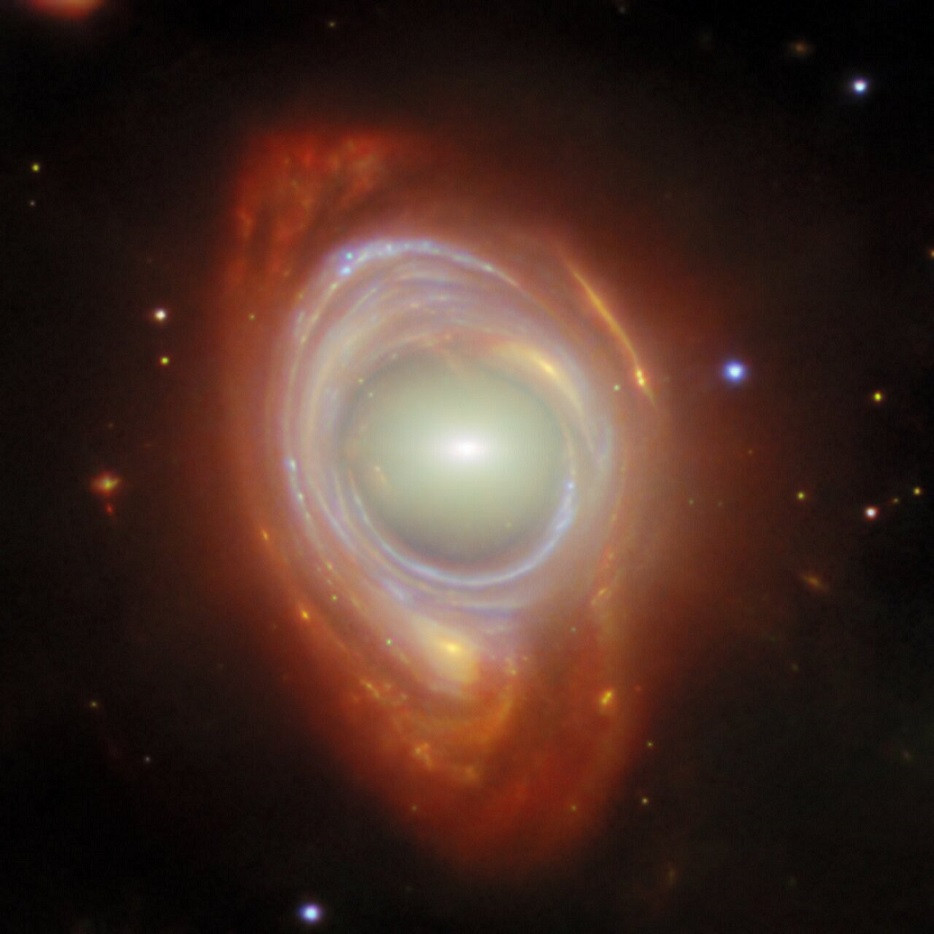🧵
For people who missed it, there is a #JWST recent image
depicting a rare and fascinating astronomical phenomenon: an Einstein ring.
➡️ https://esawebb.org/images/potm2503a/
The spectacular image shows two distant galaxies, which at first glance look like a single galaxy
🔭 🧪 #extragalactic #cosmology
For people who missed it, there is a #JWST recent image
depicting a rare and fascinating astronomical phenomenon: an Einstein ring.
➡️ https://esawebb.org/images/potm2503a/
The spectacular image shows two distant galaxies, which at first glance look like a single galaxy
🔭 🧪 #extragalactic #cosmology

Comments
Such a beautiful story to this amazing vista. Thank you.
You're welcome!
I should point out that it's not the Einstein ring itself that “magnifies” distant objects, but in this case it is the elliptical galaxy at the center of the image that, acting as a gravitational lens, amplifies the light of the more distant spiral galaxy & distorts its light,
causing the ring to form.
An Einstein ring is not an “instrument” or an object that actively magnifies something; it's the visible result of a gravitational lensing phenomenon, predicted by Einstein's general relativity. When a massive mass, such as the elliptical galaxy in the foreground of
this pic, is between us & a more distant object (the spiral galaxy), its gravity bends space-time, deflecting the rays of light coming from the object in the background. If the alignment between the lens (the elliptical galaxy), the source (the spiral galaxy), and the observer is nearly perfect,
the light from the source is distorted into a ring around the lens, hence the name “Einstein ring.”
In essence, the Einstein ring is the visual result of the distorted light, not the cause of the magnification. The cause is the mass of the elliptical galaxy.
But the most interesiting thing about it is how cnt you tell there are two galaxies instead of one big object.
I only can think of 1) measuring redshift, or 2) different observations hoping to see some difference (at galactic distances that might be lucky I guess).
Probably there are better ways to do it.
(For instance, looking at the image and tryting to simulate how can we get this kind of object... with a lot of hard work, sweat, and tears).
In summary, the astronomers considered:
1. Different redshifts to establish the distinct distances of the two galaxies.
2. Spectroscopy to confirm that the properties of the light are different between the center (elliptical galaxy) and the ring (spiral galaxy).
3. Gravitational lensing models to verify that the foreground galaxy can distort the light of the background galaxy in a way consistent with the observed Einstein ring.
4. Comparison and integration with data provided by Hubble telescope.
Much more complex than my naive approach.
But still I feel it is a great achievemente we can confidently see and describe marvels of the universe like that.
Thank you for your explanation :-)
with an unusual shape, reminiscent of a kind of "cosmic eye".
In reality, the foreground galaxy, located in the center of the image, acts as a "gravitational lens", bending the light coming from the more distant galaxy in the background.
This phenomenon, predicted by Einstein's theory of general relativity, occurs because the mass of the foreground galaxy curves space-time, deviating the rays of light from the distant galaxy and creating a bright ring around itself, known as an Einstein ring.
The galaxy, acting as a lens,
is an elliptical galaxy, part of the SMACSJ0028.2-7537 galaxy cluster, and is characterized by a bright nucleus.
The galaxy in the background is a spiral galaxy with its arms distorted by gravitational lensing, but still retaining visible structures such as star clusters and regions of gas.
The data for this image comes from the SLICE survey, led by Guillaume Mahler from the University of Liège, which uses the JWST's NIRCam instrument to study the evolution of galaxy clusters over a time span of 8 billion years. The image also integrates observations from the Hubble telescope.
The scientific value of this image is considerable. The Einstein rings are a direct test of the theory of general relativity & offer a unique opportunity to study the distribution of mass, including dark matter, in the lensing galaxy & the surrounding universe. In addition, gravitational lensing
amplifies the light of distant galaxies, allowing astronomers to observe details of objects otherwise too faint or distant to study.
This particular Einstein ring allows scientists to study a distant spiral galaxy, revealing information about star formation and the structure of galaxies